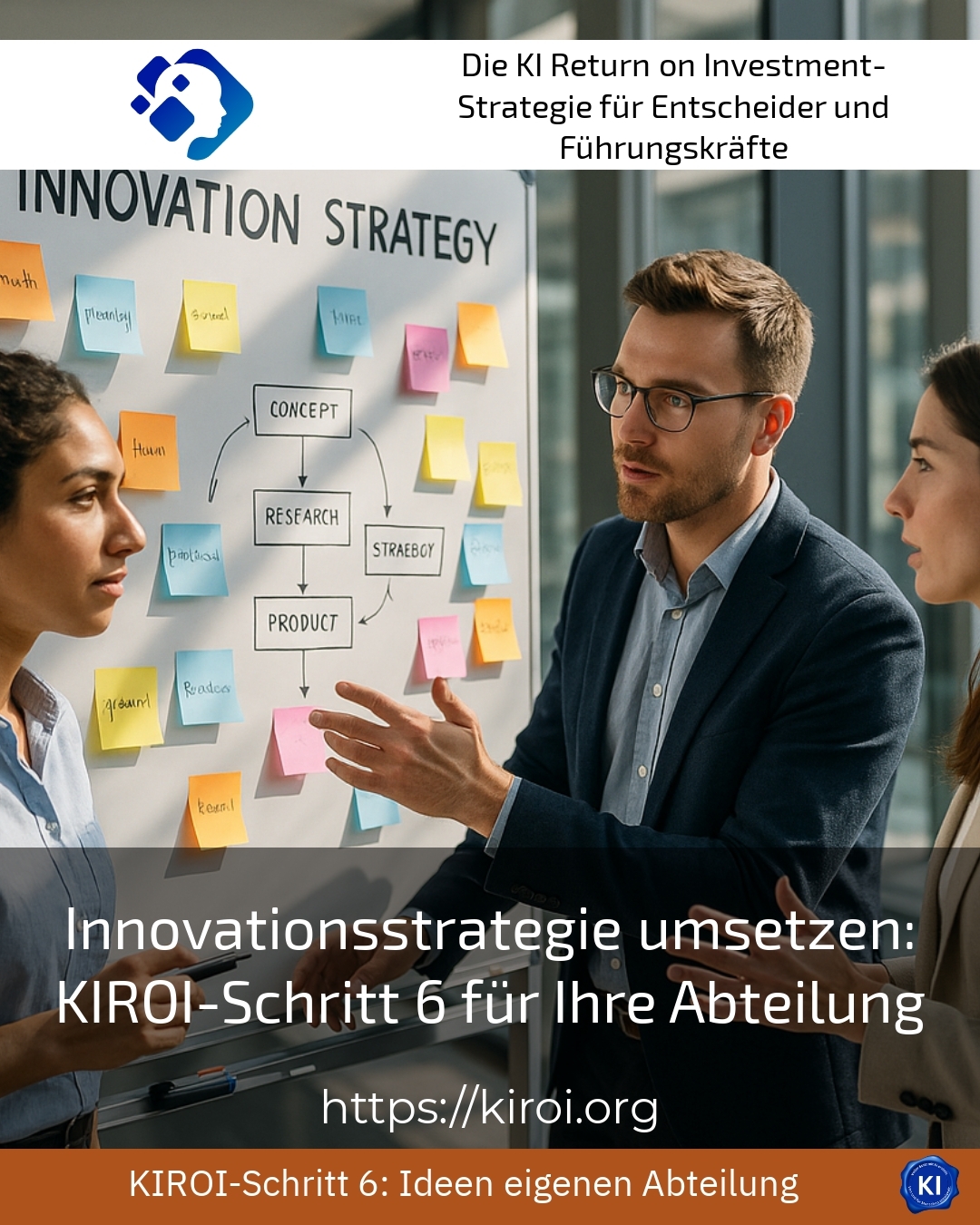A successful Innovation strategy is not a sure-fire success - it requires careful implementation in order to create sustainable momentum in the department. The sixth KIROI step is therefore entirely dedicated to the practical anchoring of the previously developed strategy. After all, real added value for the company can only be created if ideas are systematically realised. This article provides you with practical insights and recommendations on how innovation strategies can be successfully implemented in your department.
Fundamentals and importance of the innovation strategy in the implementation process
An innovation strategy describes the common thread with which new products, processes or business models are sustainably anchored in the company. It helps to deploy resources in a targeted manner and create a shared vision for everyone involved. The challenge of implementation lies in translating strategic goals into concrete measures and designing organisational processes in such a way that innovations are actually ready for the market.
In production departments, for example, process innovation is often the aim: Existing production steps are optimised in order to increase efficiency and quality. In sales, teams often rely on digital tools for customer communication in order to react more agilely to market requirements. Product development departments also oversee innovation projects, which are supported from the initial concept to the successful launch.
A clear realisation of the Innovation strategy This means that the quality of the product is decisive in determining whether planned innovations can actually be realised and generate a competitive advantage.
KIROI Step 6: Practical tips for implementing the innovation strategy
The sixth step contains many elements that are essential when implementing the innovation strategy within a department. Below you will find some key aspects with examples from various industries:
1. define clear responsibilities and governance structures
Innovation projects require clear responsibilities. In an automotive department, for example, an innovation manager is appointed to act as an interface between development and production. In service companies, an innovation officer supports the project teams in the implementation of new processes. Even in medium-sized mechanical engineering companies, project managers organise progress, coordinate resources and report to the management levels.
2. strengthen employee involvement and build communicative bridges
Involving the team increases the acceptance of new ideas. An IT department regularly organises innovation workshops in which all employees can contribute their suggestions for improvement. In the healthcare sector, interdisciplinary round tables are established to include different perspectives in product development. Regular updates and transparent feedback processes also promote dialogue and strengthen the culture of innovation in the consumer goods industry.
BEST PRACTICE with one customer (name hidden due to NDA contract) A logistics company used the sixth KIROI step to systematically improve internal communication about innovations. Ideas were documented and jointly prioritised via clearly structured meetings and digital platforms. The result was a noticeable increase in project speed and better collaboration between departments.
3. ensure dynamic resource allocation and targeted use of financial resources
An innovation strategy depends on the right allocation of resources. In the electrical industry, departments reserve budgets for pilot projects with agile teams. Pharmaceutical companies use special micro-funds for experimental phases. In the service sector, too, time and human resources are crucial to ensure that innovation initiatives do not stall.
Measure and further develop innovation strategy
The implementation of the innovation strategy is not an end point, but an ongoing process. Companies should therefore define milestones and review them regularly. KPIs such as time to market launch, cost development or customer satisfaction after the introduction of new products help with this.
For example, a marketing department uses conversion rates to measure the success of digital campaigns in order to evaluate innovation projects. Manufacturers rely on quality indicators to monitor process innovations. In this way, continuous controlling promotes the sustainability of innovation efforts and provides impetus for adjustments.
Practical examples of monitoring in different industries:
- In the food industry, customer acceptance of newly introduced packaging innovations is regularly recorded in surveys.
- Software companies analyse usage data in order to further develop new features in a targeted manner.
- In mechanical engineering, departments use feedback from service teams to initiate product improvements.
What role does transruptions coaching play in the implementation?
Transruption coaching is designed to accompany innovation projects and support departments in proactively mastering challenges. Clients often report that external impulses help to develop new perspectives and reduce frictional losses, especially in complex innovation phases. transruptions coaching supports both the fine-tuning of the innovation strategy and the concrete implementation of the measures in a flexible and individualised manner.
BEST PRACTICE with one customer (name hidden due to NDA contract) A large industrial company used transruption coaching to overcome resistance to process innovation in production. Through targeted moderation and individual coaching, employees were motivated to actively help shape change. This led to the successful implementation of new processes within the targeted timeframe.
My analysis
The realisation of a Innovation strategy is a multi-stage process that goes beyond the mere formulation of objectives. Successful implementation involves everyone involved, creates clear responsibilities and ensures that measures are continuously adapted. Examples from different industries show how diverse this step can be - from process improvement projects in production to digital innovation workshops in marketing. Support through transruption coaching and forward-looking monitoring increase the chances that the innovation strategy will unfold its full effect and the company will remain competitive in the long term.
Further links from the text above:
Innovation strategy - Steireif eShop
Success factor 1: The innovation strategy: Introduction
Innovation strategy and innovative business strategies
Innovation management: procedure & methods
Innovation strategy - Definition - Gabler Wirtschaftslexikon
For more information and if you have any questions, please contact Contact us or read more blog posts on the topic Artificial intelligence here.















